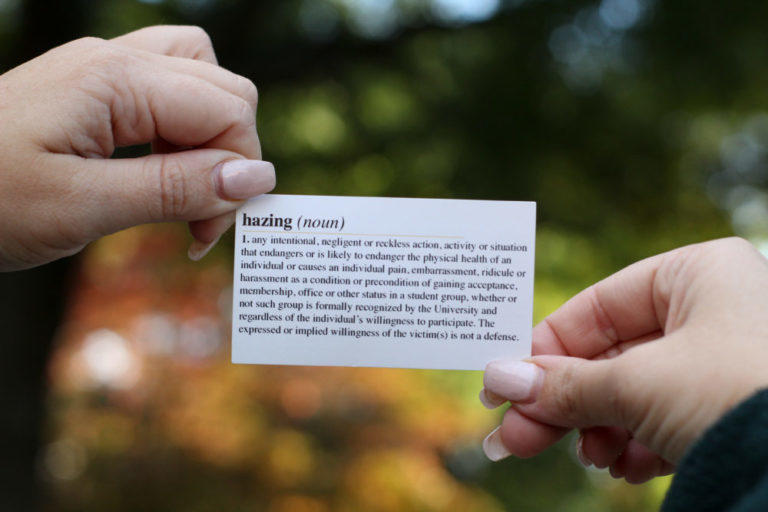
Caption
A student at Kennesaw State University holds an anti-hazing resource card from the Office of Fraternity and Sorority Life.
Credit: Sarah Swetlik/Fresh Take Georgia
|Updated: November 5, 2021 2:40 PM

A student at Kennesaw State University holds an anti-hazing resource card from the Office of Fraternity and Sorority Life.
New proposed federal anti-hazing legislation aims to establish comprehensive guidelines for universities in the United States, experts said.
The REACH Act, or H.R.2525, provides a standardized definition of hazing; calls for universities to include hazing incidents in their yearly crime statistics and to release them publicly; and mandates educational programs for students regarding hazing. REACH is short for “Report and Educate About Campus Hazing.”
The bill defines hazing as an intentional or reckless act performed by students against students, regardless of willingness to participate, committed in connection with membership in an organization at a higher educational institution. These acts either contribute to or cause physical and mental harm or degradation.
U.S. Rep. Lucy McBath, a Democrat from Roswell, Georgia, is serving as the bill’s lead sponsor. She and the late U.S. Rep. John Lewis of Atlanta were among the first 47 representatives to sign on as cosponsors of the legislation when it was first introduced in 2019 and assigned to the House Committee on Education and Labor.
McBath said in a statement Wednesday that she remembers hazing happening while she was in school, and was drawn to this bill because of hazing’s continued effects on students.
The University of Missouri-Columbia recently suspended all fraternity activities in response to the hospitalization of a freshman, who was found unresponsive following a party. This week, students protested outside of the fraternity house, calling for justice and a stop to hazing.
Three-in-five students will experience hazing while in college, though only 44 of the 50 states have a hazing-related statute, and they vary in definition and severity, a 2020 study by advocacy research group StopHazing shows. From 1959 to 2021, 2020 was the only year a hazing death was not reported nationally.
“When we see statistics about hazing, we have to remember that these are our children,” McBath said. “When we drop our kids off at college, we trust that these institutions will help protect them from harm.”
S. Daniel Carter, president of Safety Advisors for Educational Campuses, said in an interview that the REACH Act is a foundational starting point for change.
“Hazing is the last major campus safety issue that is not addressed by federal law,” Carter said.
McBath said she hopes the REACH Act will give parents some peace of mind as their children experience what university organizations have to offer without fear of abuse.
To date, families have struggled to find information about hazing-related incidents from universities before their children join organizations like fraternities, sororities, sports teams, and bands, said Dr. Elizabeth Allan, director of StopHazing.
The REACH Act would require incidents to be disclosed in the Annual Crime Statistics report in accordance with the Clery Act. These reports would be accessible on university websites, allowing families to search for incidents that happened on their campus of choice, and would contribute to national data.
Allan, who said in an interview that she began researching hazing in the 1990s, found that people often knew about it, but turned a blind eye. The REACH Act uses a socio-ecological model to discuss four levels of violence prevention and analyze patterns in hazing incidents.
This story comes to GPB through a reporting partnership with Fresh Take Georgia.